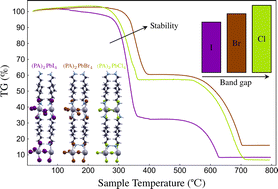Optoelectronic and stability properties of quasi-2D alkylammonium based perovskites
Abstract
Electronic and stability properties of quasi-2D alkylammonium perovskites are investigated using density functional theory (DFT) calculations and validated experimentally on selected classes of compounds. Our analysis is focused on perovskite structures of formula (A)2(A′)n−1PbnX3n+1, with large cations A = butyl-, pentyl-, hexylammonium (BA, PA, HXA), small cations A′ = methylammonium, formamidinium, ethylammonium, guanidinium (MA, FA, EA, GA) and halogens X = I, Br, Cl. The role of the halogen ions is outlined for the band structure, stability and defect formation energies. Two opposing trends are found for the absorption efficiency versus stability, the latter being assessed with respect to possible degradation mechanisms. Experimental validation is performed on quasi-2D perovskites based on pentylammonium cations, namely: (PA)2PbX4 and (PA)2(MA)Pb2X7, synthesized by antisolvent-assisted vapor crystallization. Structural and optical analysis are inline with the DFT based calculations. In addition, the thermogravimetric analysis shows an enhanced stability of bromide and chloride based compounds, in agreement with the theoretical predictions.



 Please wait while we load your content...
Please wait while we load your content...